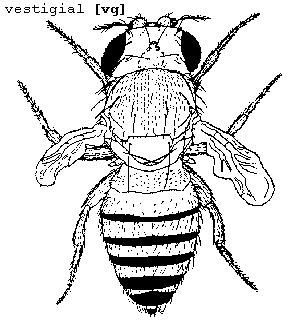


VESTIGIAL [vg]
Lindsley & Grell, 1972, p. 261
location: 2-67.0.
origin: Spontaneous.
discoverer: Morgan, 101.
references: Bridges and Morgan, 1919, Carnegie Inst. Wash. Publ. No. 278: 150 (fig.).
Mohr, 1932, Proc. Intern. Congr. Genet., 6th. Vol. 1: 190-212.
phenotype: Wings reduced to vestiges; usually held at right angles to body. Wing veins still visible. Halteres also reduced. Postscutellar bristles erect. Viability somewhat reduced. Final size of larva smaller than wild type; pupation is slightly later. Wing disks of late larva markedly smaller than wild type (Auerbach, 1936, Trans. Roy. Soc. Edinburgh 58: 787-815). Haltere disks also small [Chen, 1929, J. Morphol. 47: 135-99 (fig.)]. Goldschmidt [1935, Biol. Zentr. 55: 535-54; 1937, Univ. Calif. (Berkeley), Publ. Zool. 41: 277-82] claimed that wings are more or less fully formed and subsequently eroded by degeneration during pupation. Waddington [1939, Proc. Natl. Acad. Sci. U.S. 25: 299-307; 1940, J. Genet. 41: 75-139 (fig.)] found no evidence of erosion and concluded that effect of the gene is during larval period and involves reduction in size of prospective wing area and shift in position of line along which wing area is folded out from imaginal disk. Temperatures of 29oC or greater appreciably increase wing size (Harnly, 1936, Genetics 21: 84-103; Stanley, 1935, J. Exptl. Zool. 69: 459-95). vg/+ with certain Minutes shows scalloping of wings [Green and Oliver, 1940, Genetics 25: 584-92 (fig.)]. vg/vg/+ has scalloped wings more often than vg/+ (Green, 1946, Genetics 31: 1-20). RK1.
cytology: Placed between 49D3 and 49E6, on basis of its inclusion in both Df(2R)vgB = Df(2R)49D3-4;50A2-3 and Df(2R)vgD = Df(2R)49C1-2;49E2-6 (Morgan, Bridges, and Schultz, 1938, Carnegie Inst. Wash. Year Book 37: 304-9).
color figure: P. A. Otto (original)
b & w figure: Morgan, Bridges and Sturtevant, 1925, The Genetics of Drosophila, Bibliog. Genet. 2: 1-262 (original drawn by Edith M. Wallace)
photograph: P. A. Otto (original)


